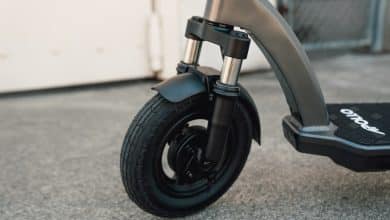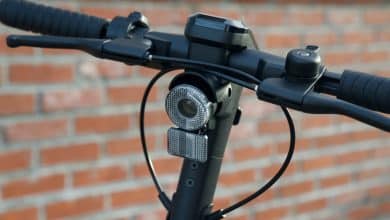Which Scooter Is Right for You? A Deep Dive into the Apollo Go vs the Apollo Explore 2.0
If you’re trying to decide between the Apollo Go and the Apollo Explore 2.0, you’re not alone. These two scooters now sit in a similar price tier, but they’re built for different riders and different uses. In this article, we’ll walk through their strengths and weaknesses, compare performance, build quality, ride experience, and help you figure out which one suits you.
Table of Contents
The Big Picture: Two Scooters, Two Vibes
The Apollo Go is a compact, agile commuter scooter: dual motors, lightweight, ready to dart through city traffic and handle public-transportation transitions. Meanwhile, the Apollo Explore 2.0 is more a “mini performance” scooter: bigger tires, more suspension, higher-voltage system, more premium feel. The manufacturer positions it as a scaled-down version of their more serious high-end models.
So while they may look similar at a glance and may even cost close to each other, the key is: they serve different rider profiles.
Performance Comparison
Let’s break down the specs and what they mean in real-world riding.

Apollo Go
We’ve tested more than 200+ Electric Scooters and every Apollo scooter that’s come are way has been fantastic. The Go is a classic that is worth checking out.
Acceleration & Motors
- The Apollo Go uses dual motors. This gives it a strong initial punch off the line—great for city starts, stop-and-go traffic. For example, in one test it hit 15 mph in ~4.18 seconds, besting the Explore.
- The Explore 2.0 uses a single motor but on a higher-voltage 48 V system (in its spec sheet) and a “Core Fusion” motor according to one review. Apollo Scooters+2Electric Scooter Guide+2
- On climbs or with heavier riders, the stronger torque of the Explore can make a difference. If you ride hilly terrain or you’re on the heavier side, the Explore may hold up better.
Top Speed & Range
- The Apollo Go’s top speed is around 28 mph (manufacturer spec) though in tests closer to 25–26 mph.
- The Explore 2.0 lists a top speed of 25 mph in some specs. Apollo Scooters+1
- Range: In real-world tests a heavier rider (~235 lb) got ~20.6 miles on the Explore and ~18.6 on the Go on the same course. (Of course your results will vary based on weight, terrain, speed.)
- The Go is lighter and more nimble; the Explore has more “headroom” for heavier weight/rougher terrain.
Which road type suits each?
- City commute (sidewalks, traffic lights, sharp turns): Go wins for agility and portability.
- Longer urban routes or rougher surfaces (bumpy sidewalks, mild off-pavement, heavier rider): Explore offers more comfort and stability.

Apollo Explore 2.0
We’ve tested more than 200+ Electric Scooters and every Apollo scooter that’s come are way has been fantastic. The Explore 2.0 is a new favorite.
Build Quality, Ride Comfort & Features
Tires, Suspension & Ride Feel
- The Go comes with 9-inch tires and full suspension (front + rear) appropriate for city-use.
- The Explore 2.0 upgrades: 10-inch tires, triple-spring suspension (one front, two rear) according to the walkthrough. Electric Scooter Guide+1
- For larger riders or uneven roads, the Explore’s ride will feel more planted. For pure maneuvering in tight urban spaces, the Go shines.
Portability & Weight
- Go weighs about 46–49 lb depending on spec. Best Buy+1
- Explore 2.0 is heavier (around 60 lb in spec sheet) due to larger tires, suspension, reinforced stem. Apollo Scooters Canada+1
- If you carry your scooter into an apartment, up stairs, or into public transit often, the lighter Go offers a clear advantage.
Extra Features & App Integration
Both scooters benefit from the manufacturer’s mobile app platform: you can adjust ride modes, regenerative braking, track performance metrics, and engage with community features like ride-challenges or points. This adds value beyond the hardware alone.
The Explore includes premium touches (better lighting, turn-signals, more robust latch/fold mechanism) in some reviews. Electric Scooter Guide
Which Scooter Is Right for You?
Here’s a summary to help guide your decision:
Choose the Apollo Explore 2.0 if you:
- Ride on mixed surfaces (some rough pavement, mild off-pavement)
- Are heavier (200 lb+), or plan to consistently carry heavier loads
- Want a more “premium feel” with larger tires, better suspension
- Prioritize stability and comfort over ultimate portability

Apollo Explore 2.0
We’ve tested more than 200+ Electric Scooters and every Apollo scooter that’s come are way has been fantastic. The Explore 2.0 is a new favorite.
Choose the Apollo Go if you:
- Mostly ride on smoother city pavements, sidewalks, bike-lanes
- Need something you can easily carry, fold, stow in a trunk or small apartment
- Appreciate dual motors for quick starts in urban traffic
- Want “very good” performance with better portability, and maybe fewer compromises

Apollo Go
We’ve tested more than 200+ Electric Scooters and every Apollo scooter that’s come are way has been fantastic. The Go is a classic that is worth checking out.
Final Thoughts
Both the Apollo Go and the Explore 2.0 deliver strong value in their class. The key difference is how and where you ride. If your riding style is urban, agile, daily commute-focused, the Go makes a lot of sense. If you want more “ride quality” and comfort and are willing to live with a heavier machine, the Explore 2.0 gives you more scope.
When you buy, remember: actual performance will depend on rider weight, terrain, speed habits, and how well you maintain your scooter (tire pressure, battery health, etc.). Also check your local regulations for scooter use (speed limits, required equipment) because laws vary by state and city.
If you like, I can pull together a spec comparison table (with price, dimensions, build materials, etc.) and highlight pros/cons in one side-by-side view. Would that be helpful?




